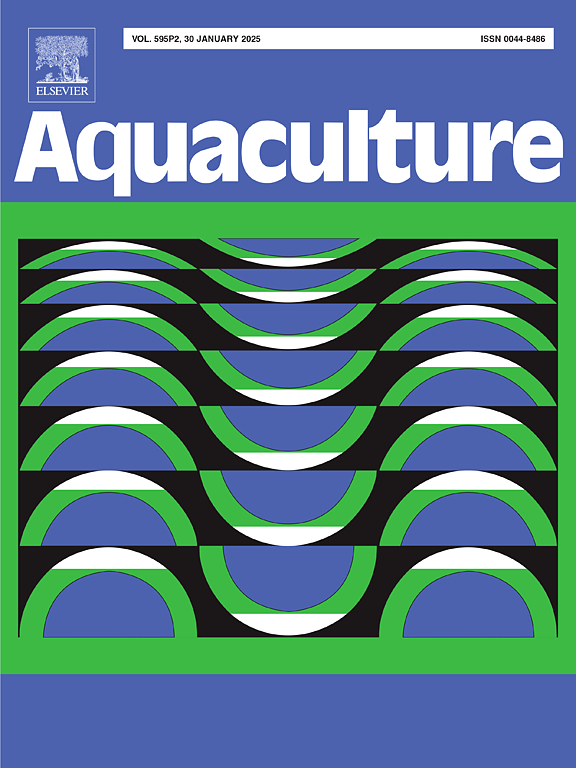Production of donor-derived Atlantic salmon progeny using allogeneic surrogate broodstock technology
IF 3.9
1区 农林科学
Q1 FISHERIES
引用次数: 0
Abstract
Surrogate broodstock technology enables upscaled production of fish carrying desirable genetics via transplantation of germline stem cells (GSCs) into recipients (the surrogates), which will produce progeny from viable and functional donor-derived gametes. This technology constitutes an important tool for aquaculture and conservation biology, allowing for propagation of limited and valuable genetic resources. In this study, gonadal cell suspensions containing GSCs were prepared from sexually immature female and male Atlantic salmon (Salmo salar) and transplanted separately into mixed-sex triploid hatchlings of the same species. One year post-transplantation, two sampled females exhibited one or both ovaries fully populated with developing perinucleolar oocytes, unlike control triploid ovaries showing undifferentiated oogonial nests only. Male gonads were indistinguishable between groups, filled with type A spermatogonia; however, in a separate experiment, gonadal donor cells labeled with PKH26 were still observed within the surrogate's testes 160 days post-transplantation. Later examinations revealed three additional female surrogates sexually maturing displaying ovaries with oocytes at primary growth or late vitellogenic stages. Three years post-transplantation, five male surrogates matured, and the sperm produced was used to fertilize eggs collected from a standard diploid female. Ploidy and microsatellite analyses confirmed that diploid progeny were generated from two of the surrogates. Finally, four years post-transplantation, three female surrogates ovulated eggs that were fertilized with standard haploid sperm, resulting in diploid donor-derived progeny. As juveniles, all sampled progeny from the three crosses were confirmed diploid donor-derived, showing optimal growth and normal gonadal development. Interestingly, all donor-derived progeny originated from surrogates transplanted with male GSCs, which indicates that male GSCs adapted to the female somatic environment, changed their fate and underwent oogenesis, resulting eventually in the production of functional X:Y eggs. Fertilization of X:Y eggs with standard X:Y sperm resulted in the expected 3:1 male to female sex ratios and the production of ∼1/3rd YY super-males within the F1 offspring. In summary, we demonstrate for the first time that donor-derived functional gametes and progeny can be produced from Atlantic salmon through gonadal cell transplantation into sterile triploid surrogates of the same species. Our results also suggest that both salmon sexes are suitable as surrogates, although higher progeny numbers and survival rates were achieved when using female surrogate parents. Implementing such technology represents a powerful addition to existing breeding programs, allowing more efficient selection and upscaled production of key genetic traits to overcome sustainability challenges in salmon aquaculture.
利用同种异体代亲鱼技术生产供体来源的大西洋鲑鱼后代
通过将生殖系干细胞(GSCs)移植到受体(代孕体)中,代孕体将从有活力和功能的供体配子中产生后代,代孕亲鱼技术可以实现携带理想遗传基因的鱼的规模化生产。这项技术是水产养殖和保护生物学的重要工具,使有限而宝贵的遗传资源得以繁殖。本研究从性成熟的雄性和雌性大西洋鲑鱼(Salmo salar)中制备了含有GSCs的性腺细胞悬液,并将其分别移植到同一物种的混合性三倍体幼体中。移植一年后,两只取样的雌性卵巢显示出一个或两个卵巢充满了发育中的核周卵母细胞,不像对照的三倍体卵巢只显示未分化的卵巢。各组间雄性性腺无明显差异,充满A型精原细胞;然而,在另一项单独的实验中,移植后160天,在代孕者的睾丸内仍然观察到PKH26标记的性腺供体细胞。后来的检查发现另外三个性成熟的女性代孕者显示卵巢的卵母细胞处于初级生长或卵黄形成晚期。移植三年后,5个雄性代孕体成熟,产生的精子被用来与从标准二倍体雌性收集的卵子受精。倍性和微卫星分析证实,其中两个代体细胞产生了二倍体后代。最后,移植四年后,三名女性代孕者排卵,与标准单倍体精子受精,产生二倍体供体后代。作为幼体,三个杂交的所有子代均为供体来源的二倍体,具有最佳的生长和正常的性腺发育。有趣的是,所有的供体衍生后代都来自于移植了雄性GSCs的代体细胞,这表明雄性GSCs适应了雌性体细胞环境,改变了它们的命运并进行了卵子发生,最终产生了功能性的X:Y卵子。X:Y卵子与标准X:Y精子的受精结果是预期的3:1的男女性别比,并且在F1后代中产生1/3的YY超级雄性。总之,我们首次证明,通过将大西洋鲑鱼的性腺细胞移植到同一物种的不育三倍体替代物中,可以产生供体来源的功能配子和后代。我们的研究结果还表明,尽管使用雌性代孕父母可以获得更高的后代数量和存活率,但两种性别的鲑鱼都适合作为代孕母亲。实施这种技术是对现有育种计划的有力补充,可以更有效地选择和扩大关键遗传性状的生产,以克服鲑鱼水产养殖中的可持续性挑战。
本文章由计算机程序翻译,如有差异,请以英文原文为准。
求助全文
约1分钟内获得全文
求助全文
来源期刊

Aquaculture
农林科学-海洋与淡水生物学
CiteScore
8.60
自引率
17.80%
发文量
1246
审稿时长
56 days
期刊介绍:
Aquaculture is an international journal for the exploration, improvement and management of all freshwater and marine food resources. It publishes novel and innovative research of world-wide interest on farming of aquatic organisms, which includes finfish, mollusks, crustaceans and aquatic plants for human consumption. Research on ornamentals is not a focus of the Journal. Aquaculture only publishes papers with a clear relevance to improving aquaculture practices or a potential application.
 求助内容:
求助内容: 应助结果提醒方式:
应助结果提醒方式:


